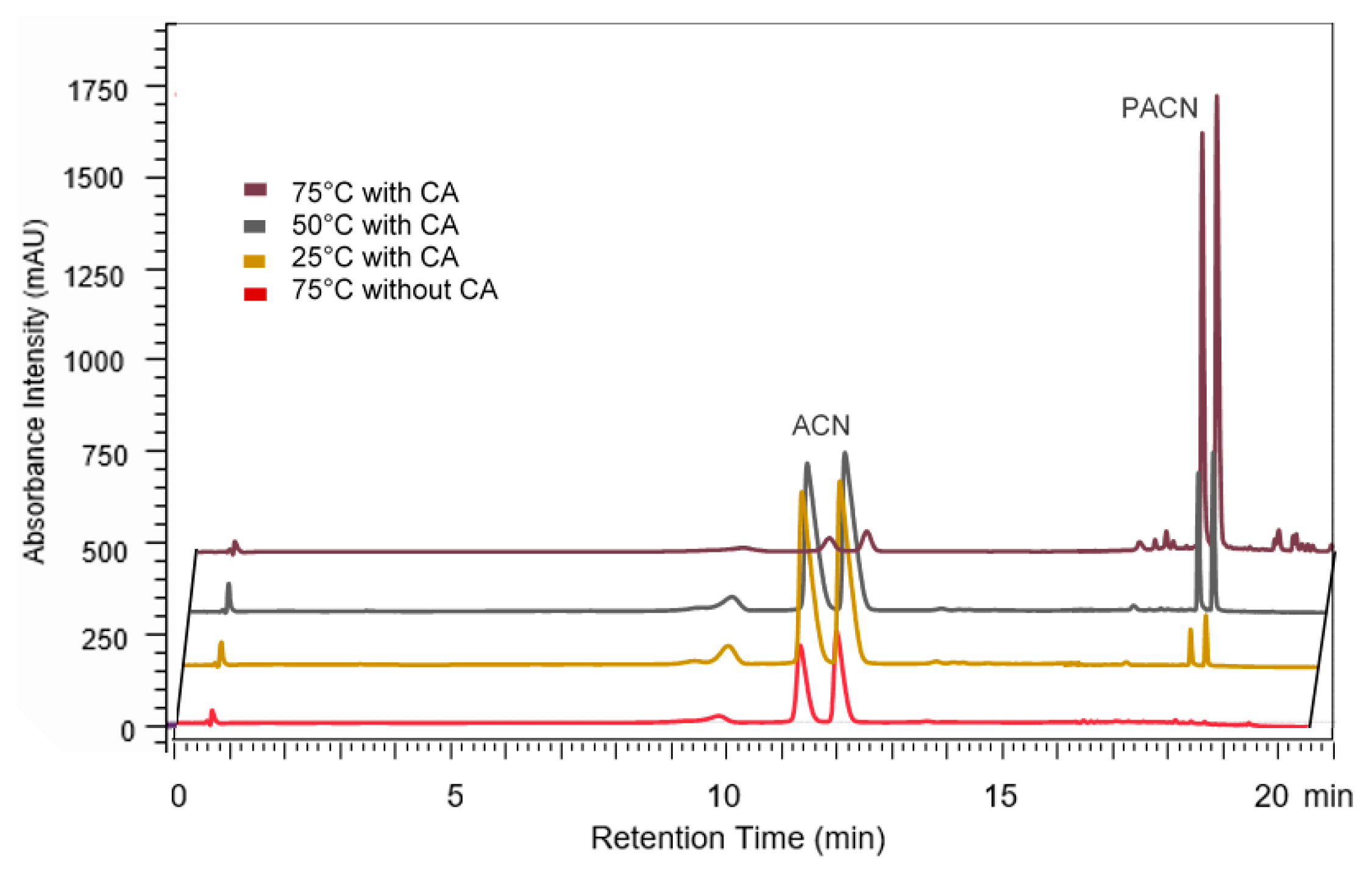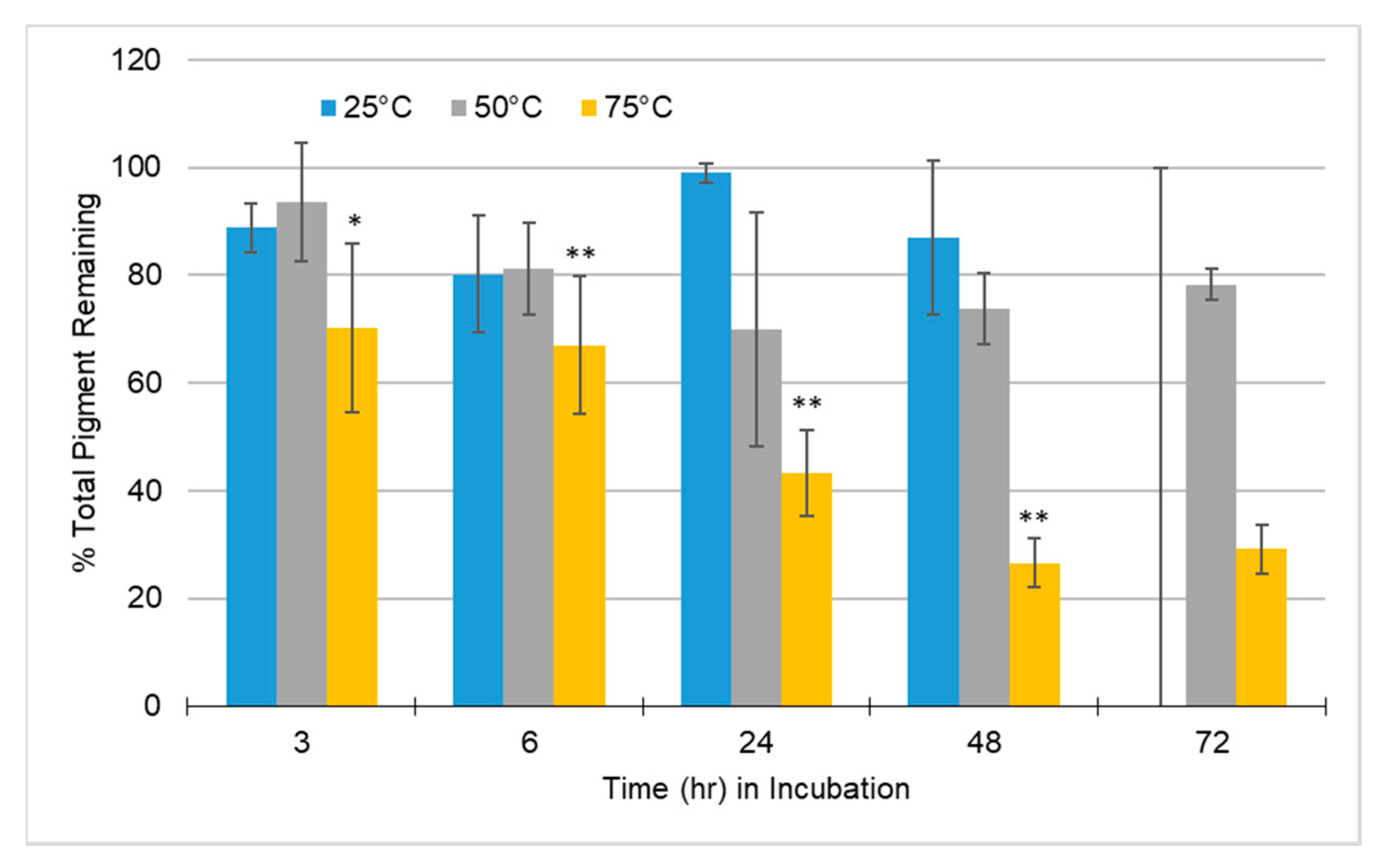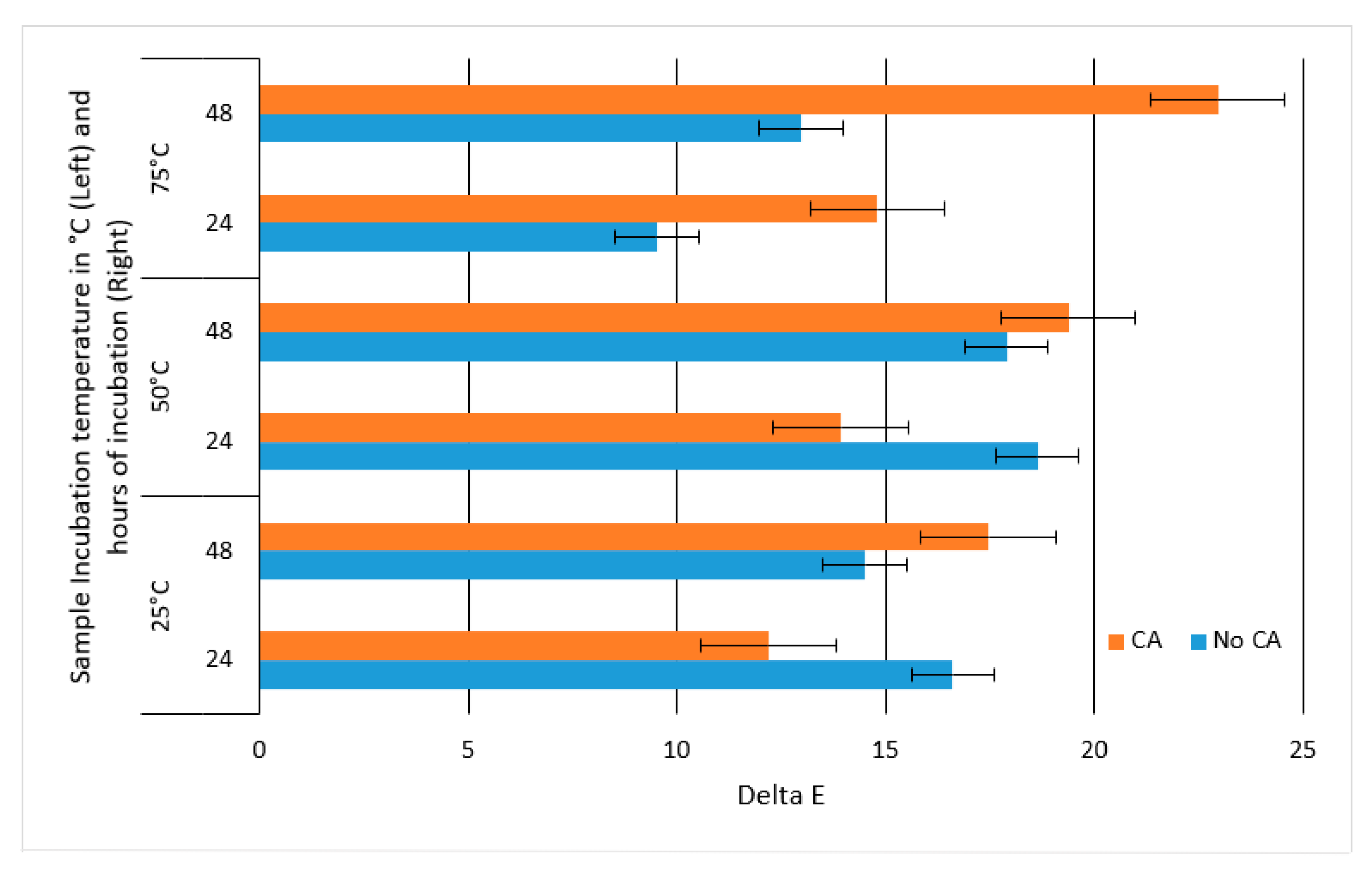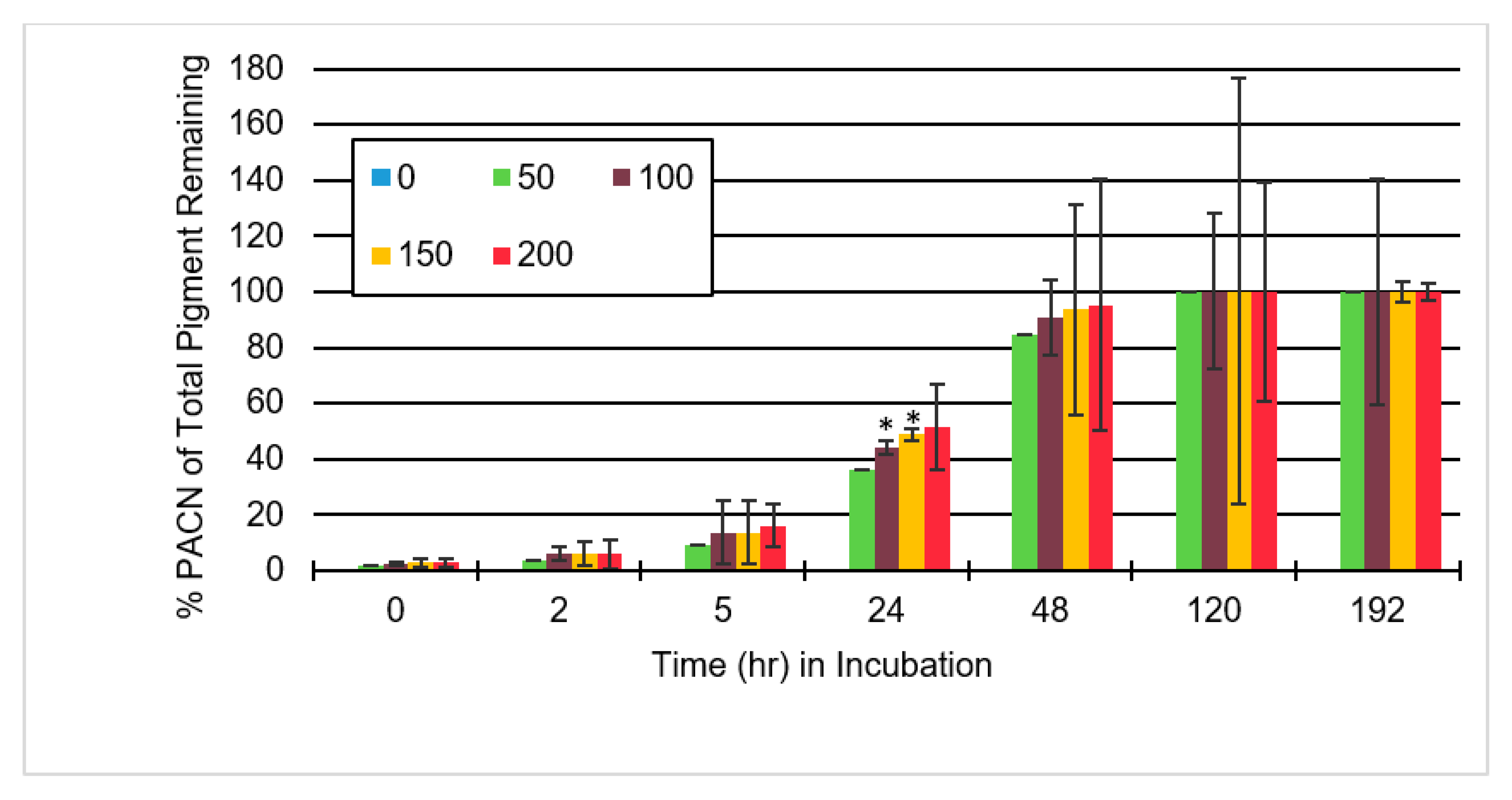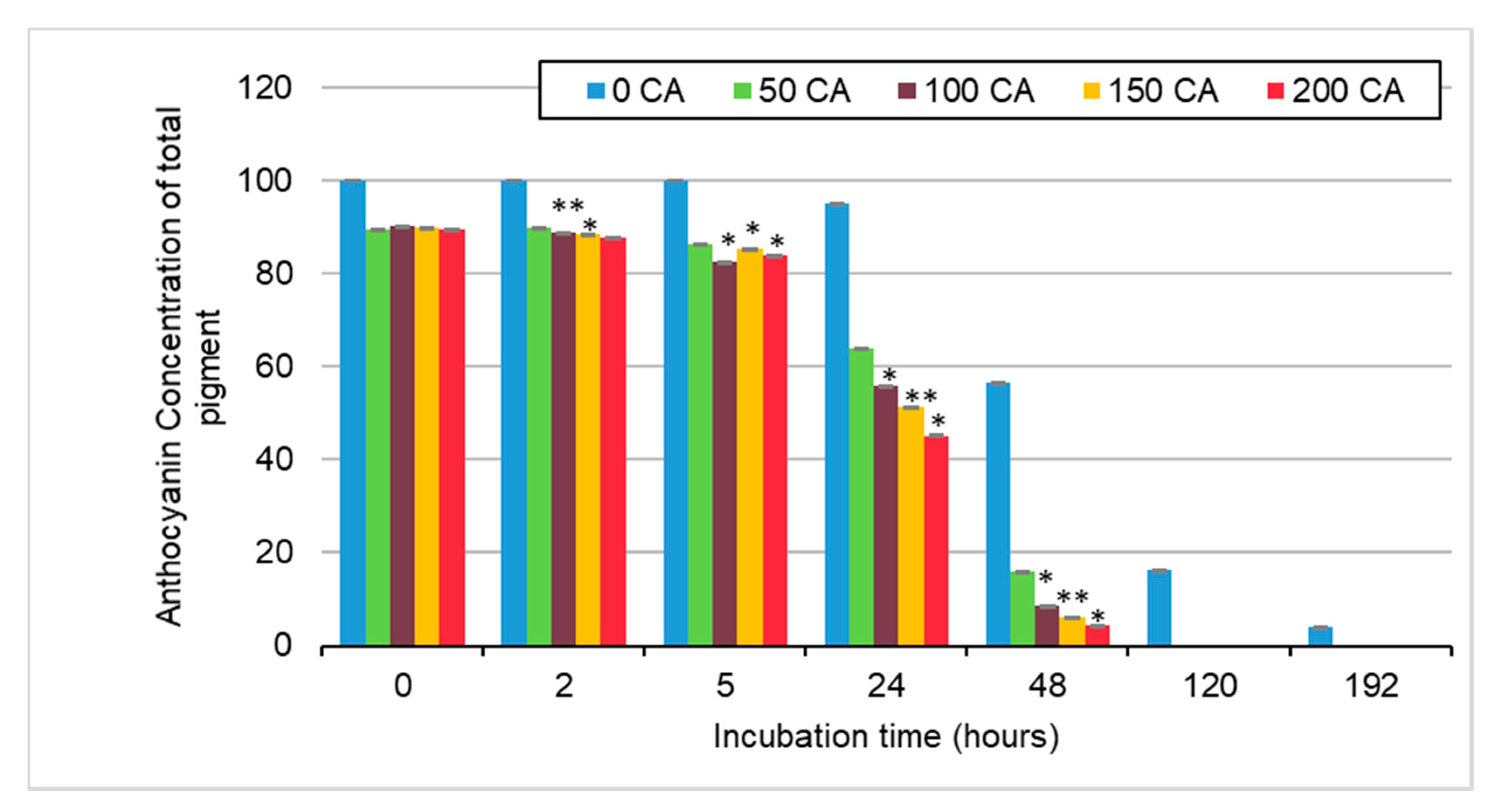1. Introduction
People experience colors daily that not only affect their feelings, but also their decisions. Food color is an important characteristic that has been used for over a century to help consumers identify and differentiate product safety, sensory, and quality characteristics [
1]. However, many consumers do not trust artificial ingredients and look for natural alternatives. In one study, scientists determined that artificial colorants increase hyperactivity in children [
2]. This study raised concerns and lead numerous countries to ban specific artificial food colorants.
Naturally derived alternatives have become an important area of research, with anthocyanins (ACN) receiving a fair share of attention. These compounds are plant pigments found in many plants that act as powerful antioxidants and may provide health benefits. Unfortunately, they are unstable and lose their vibrancy over time. Therefore, scientists asked: What is a food that has color for a very long time? The answer was found in wine. Scientists studying wine found pyranoanthocyanins (PACN), which are anthocyanin-derived pigments.
Pyranoanthocyanins were first discovered in red wine in 1996 as a crucial component of wine color [
3,
4]. That same year, the structure was determined through NMR and showed the pyran ring attached between the C-5 hydroxyl group and C-4 [
5]. Because of the additional pyran ring, pyranoanthocyanins have a
λmax that is hypsochromically shifted and expresses a more orange color compared to authentic anthocyanin pigments [
4]. This additional ring makes PACN a much more stable pigment that is better suited for food processing environments [
6]. Unfortunately, they are formed very inefficiently over time. As shown in wine, color development from PACN can take months to years [
7]. In a food processing setting, storing the pigment for that amount of time is a cost not many are willing to spend. Increasing the formation rate of PACN is a relevant area of research. PACN require anthocyanins, a reaction partner, and storage time for formation [
4]. PACN formation in food is dependent on the concentration of both the anthocyanins and the reaction partner. In wine, PACN form and cause color changes through aging, which can take months through to decades. Because of the increased stability of this pigment, studies look for ways to increase the rate of formation. Pinotin A, a hydroxyphenyl-pyranoanthocyanin, was shown to have the fastest formation in Pinotage wine. In this time period of 3 to 4 years, concentration of anthocyanins had significantly decreased, leading to an increase in the caffeic acid to anthocyanin ratio [
8]. One study looked at using microwave-assisted extraction to increase PACN formation at differing grape ripeness levels [
9]. Another study was able to reduce PACN formation to 42 days by increasing storage temperature to 25 °C [
10]. However, with increased temperature, anthocyanin degradation also increases. The benefit of gaining a more stable pigment needs to be weighed with the loss of the initial pigment. Nonetheless, the efficient formation of PACN would be an asset to the food industry as they work towards eliminating artificial food colorants.
It has been shown that increasing storage temperature from refrigeration to room temperature can increase PACN formation; however, temperatures beyond room temperature have not been evaluated [
10,
11]. These studies also found that caffeic acid is an effective cofactor in producing PACN. However, excessive caffeic acid used without obtaining significant increases in PACN formation would be a costly waste of product for producers. Additionally, too much caffeic acid may cause astringent flavor development [
12]. Determining the amount of caffeic acid that is beneficial to the development of PACN without sacrificing other characteristics could save producers money as they switch to naturally derived colorants.
This study consisted of two main objectives: to determine if using high incubation temperature would increase PACN formation significantly and to determine if using a higher concentration of cofactor and temperature would increase PACN formation enough for use as a naturally derived colorant. With the addition of significantly more heat, it is hypothesized that PACN formation and anthocyanin degradation will both increase. Furthermore, we expected that the increase in caffeic acid concentrations with a high incubation temperature would increase PACN formation, but that it may not be significant.
2. Results and Discussion
There were three main anthocyanins eluted from the sample including cyanidin-3-glucoside, cyanidin-3-sambubioside, and cyanidin-3-sambubioside-5-glucoside. The identification of cyanidin-3-glucoside and cyanidin-3-sambubioside confirmed that the elderberry sample was an ideal anthocyanin source for PACN formation. The free hydroxyl group at the C5 position of these main anthocyanins allowed for a cofactor to condense and form PACN. These results agreed with literature by Lee and Finn, which found that the first two small anthocyanin peaks are cyanidin-3-sambubioside-5-glucoside and cyanidin-3,5-diglucoside, respectively [
13]. They determined that the next two larger anthocyanin peaks were cyanidin-3-sambubioside and cyanidin-3-glucoside, respectively. MS/MS data were used for pigment identification. A large portion of the sample was made up of peaks two and three (cyanidin-3-glucoside and cyanidin-3-sambubioside) (
Figure 1).
With the main anthocyanins in this sample having a free hydroxyl group at the C5 position, this sample was an ideal candidate for PACN formation. When the sample was analyzed using the uHPLC-MS/MS-PDA methods described in the methods section, our results agreed with those described previously by Lee and Finn. The two peaks that eluted around 18 min were the PACN peaks, but when the sample was not incubated, the amount was very minimal. It was, however, present in the sample containing caffeic acid at low concentrations because of the time that passed between sample preparation and analysis.
After 24 h incubation at higher temperatures, the anthocyanin peak areas decreased faster, while the PACN peak areas increased faster over time than at lower temperatures (
Figure 2). The reverse was true at lower temperatures, with greater anthocyanin peak area and smaller PACN peak areas after 24 h of incubation.
By comparing PACN formation and anthocyanin degradation, it can be seen that at lower temperatures the anthocyanin degraded less but formed less PACN (
Figure 2). On the contrary, at higher incubation temperatures, PACN formation was greater and anthocyanin degradation was greater. Therefore, past a specific time, incubation was counterproductive because it will not increase PACN significantly while continuing to degrade anthocyanin pigments consistently.
Figure 3 showed a significant increase in PACN formation at 75 °C compared to 25 °C and 50 °C.
Within 24 h, there was 86% PACN and within 48 h the sample was 100% PACN. Incubating beyond 48 h decreased total pigment. Because of anthocyanin sensitivity to heat, degradation of pigment is expected at high temperatures [
14,
15]. According to
Figure 3, it would be nearly pointless to incubate beyond 48 h under these conditions. Even though PACN is more stable, at 75 °C incubation there may still be minimal pigment loss. At 48 h of incubation under such a high heat, the greatest concentration of PACN has already been reached and continued incubation leads to unnecessary loss of pigment and wasted energy.
In the samples analyzed, at higher temperatures, degradation of total pigment occurred more rapidly than at lower temperatures (
Figure 4).
Looking at the results shown in
Figure 4, it could be argued that the production of PACN would be more efficient at 24 h versus 48 h because of the significant difference between 6 and 24 h versus the minimal difference between the former (
Figure 3). The processing cost of storing and incubating the sample combined with the loss in pigment remaining may not be worth the minimal increased PACN content. Although pigment was lost through the incubation of sample and formation of PACN, the amount of PACN present in the sample was comparatively substantial. A similar study incubating samples at 25 °C required 42 days to obtain the PACN levels obtained within one day in this study at 75 °C [
10]. Being able to produce PACN within one day versus several weeks or months increases the practicability of producing PACN in the food industry as a naturally derived alternative to artificial colorants.
Because of the loss of anthocyanins and the formation of PACN, a color change occurred in the sample. According to
Figure 5, at 25 °C and 50 °C, the ΔE*
ab was greater at 48 h than 24 h with caffeic acid. At 75 °C, the delta E increased with caffeic acid between both 24 and 48 h when compared to no incubation.
Figure 5 showed that with the formation of PACN the ΔE*
ab increased, indicating a change in the pigment. Each ΔE*
ab was greater than five. This pigment could therefore not replace anthocyanins, but it may be used in tandem with them.
The PACN content increased consistently with an increase in caffeic acid concentration, but it did not increase significantly (
Figure 6). Therefore, under the conditions tested it may not be worth adding more than an ACN:CA molar ratio of 1:50.
Because
Figure 6 shows a consistent but not a significant increase in PACN present, the addition of more caffeic acid may have more of a negative effect than the benefits it provides. Too much caffeic acid may cause astringent flavor development and may become a costly investment for producers. Within 48 h, samples containing caffeic acid had all achieved PACN concentrations of at least 80%, while at 120 h all samples contained 100% PACN. With at least 80% PACN in the sample with ACN:CA molar ratios of 1:50, the sample may already contain enough pigment and have enough tinctorial strength for what is required.
In
Figure 7 we can see that through incubation, anthocyanin concentration decreased over time. We can also see that the anthocyanin concentration decreases more rapidly at higher concentrations of caffeic acid.
This would suggest that much of the loss of anthocyanins is attributed to the formation of PACN. As is also shown in
Figure 6, we can see that between 24 and 48 h there was a significant (
p-value < 0.05) shift from anthocyanins to PACN in samples containing caffeic acid. Some time after 48 h, anthocyanins were either completely degraded or converted to PACN, as a sample with no caffeic acid was the only sample with anthocyanins remaining at 120 h.
Figure 8 showed a sample with ACN:CA molar ratios of 1:150 and 48 h of incubation had the greatest PACN conversion at 212% absorbance compared to the initial pigment.
At this time of incubation, PACN absorbance was greater than 125% of the initial sample for each caffeic acid containing the sample. This showed that with the use of caffeic acid, the amount of color expression in samples incubated for 48 h could be greater with PACN formation than the pigment in the initial sample. These results are solely based on absorbance, specifically the area under the curve for anthocyanins and relative concentration. Results could not be compared to a standard curve because of the lack of PACN standard samples. With greater color expression and stability, the pigment may be used to create and provide more reliable colors for use in the food industry. Sometime after 48 h, degradation overtook formation and total pigment decreased, meaning that under these conditions incubating past 48 h was not worth the loss of pigment, unless a pure sample of PACN is the goal.

